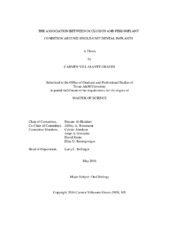| dc.description.abstract | Background: There is controversy in regards to whether occlusion plays a role in the peri-implant condition. The aim of this study was to evaluate the association between occlusion and peri-implant condition around single-unit dental implants. Materials and Methods: This cross-sectional study was conducted at the Graduate Periodontics Department of Texas A&M University BCD. Patients that had received at least one dental implant which was restored with a single-unit crown and had been in function for at least 1 year were included. The type of occlusal contact during maximal intercuspidation (MI) as well as the presence of excursive contacts on the implant during working (W), balancing (B), and protrusive (Pr) movements were recorded. Additionally, a digital sensor (T-Scan®) was used to quantify the implant relative Maximum Bite Force (rMBF) and the implant disclussion time during W, B, and Pr. Implant mobility, suppuration, pain upon vertical percussion, BOP, PD and radiographic bone loss were evaluated. Results: Forty-four patients (74 implants) participated in the study. The type of occlusal contact during MI was “heavy” in 29 implants (39%), “light” in 40 implants (54%), and 5 implants (7%) present with “no contact.” Twenty implants presented with excursive contacts on the working site, whereas 4 and 7 implants presented with balancing and protrusive contacts, respectively. The mean rMBF on the implant was 10% (±9.57). The mean implant disclussion time in the working side was 1.06 sec (±0.94), whereas it was 0.58 sec (±0.66) and 0.42 (±0.59) sec for balancing and protrusive, respectively. The mean implant deepest PD was 3.66 mm (±1.17 mm). The mean radiographic bone loss was -0.18 mm (±0.83 mm). Three implants were classified as presenting with “peri-implantitis,” whereas 24 implants presented with “peri-mucositis.” None of the occlusion variables showed a statistically significant association with any of the peri-implant condition variables (p>0.05) Conclusion: Within the limitations of the present study, it is concluded that in a properly restored sample, occlusion in single-unit dental implants does not demonstrate an association with the peri-implant condition. | en |


